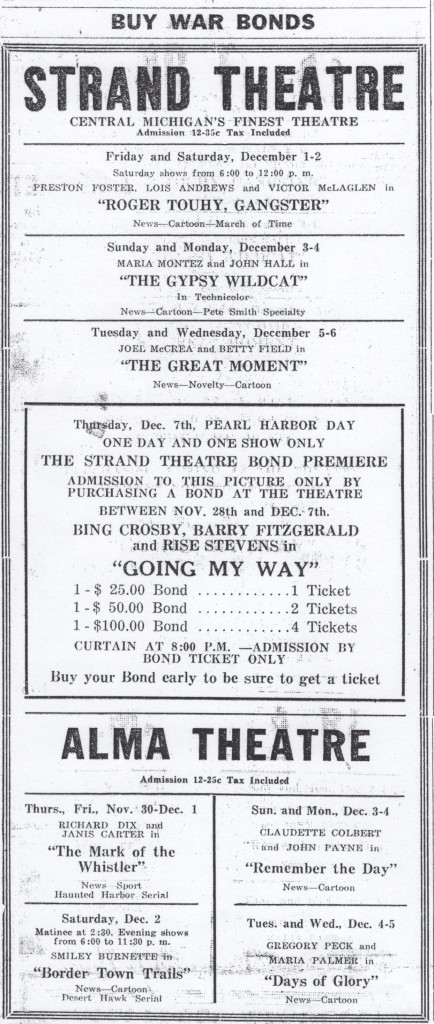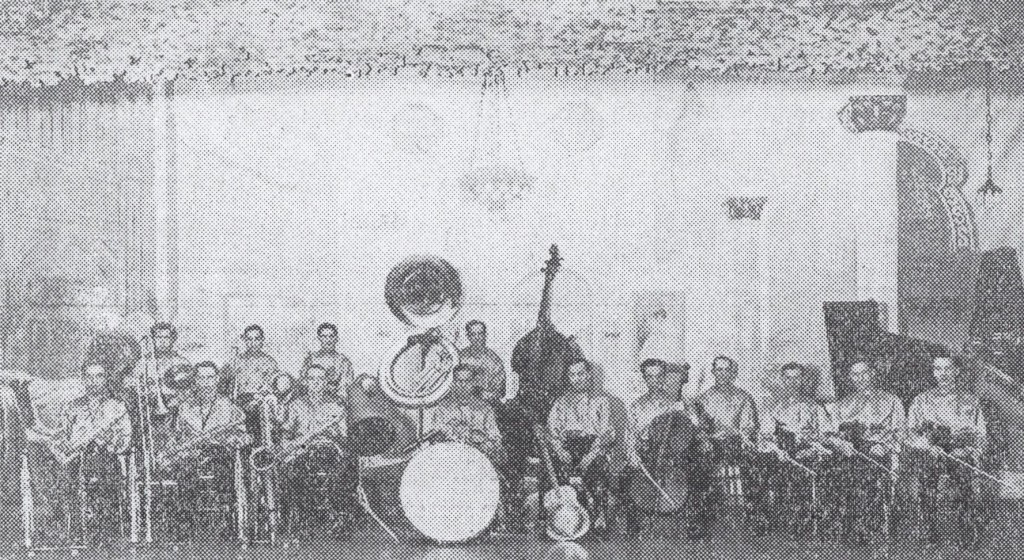By Jim Goodspeed



The late 1940s in Alma from the top: Laurence Olivier starred in “Hamlet” in May 1949. A extremely popular show, it could only be seen by reserved seat; the death of Strand Theatre owner William A. Cassidy brought an end to Alma theatre ownership that stretched back to early in the Depression; Alma Production Credit Association held its fifteenth anniversary at the Strand Theatre. PCA had a long history in Alma which enabled farm loans.
With the end of World War II, Gratiot County soon faced new problems like the continuation of rationing and increased inflation. Forms of rationing, which started after Pearl Harbor, continued into late 1946, and many things that people wanted to buy now cost more. During the late 1940s, Gratiot men who died during the war began coming home from overseas cemeteries. A postwar draft began, and those previously too young to serve in World War II now entered military service.
From late 1945 until early 1947, the only news about Alma’s theatres concerned the weekly showings of movies in local newspapers. There appeared to be no fancy advertisements or significant events during those years while moviegoers in Gratiot County adjusted to postwar life. Things started to change in August 1947 when a familiar face appeared at the Strand in the form of Kirma the Great, who had previously appeared on stage during the Depression. He claimed to be able to solve problems of love, courtship, marriage, and health with his scientific knowledge and psychic powers. Kirma displayed his talents at the Strand Theatre for an entire week as owners hoped to draw people to the Strand.
Soon, prices at the Alma theatres jumped to thirty-five cents for “outstanding pictures” shown from Sunday through Wednesday, such as Bob Hope and Dorothy Lamour in “My Favorite Brunette.” Regular shows on other days remained twenty-five cents. In the fall of 1947, the Strand started showing Children’s Matinees on Saturday mornings with the debut of “The Enchanted Forest” from the Children’s Film Library. Another favorite draw in the late 1940s included Abbott and Costello, who appeared in a run of comedic romps at the Strand in movies such as “The Wistful Widow of Wagon Gap.”
In early July 1948, the Strand Theatre again featured boxing events and showed the official pictures from Joe Louis’ last fight. Louis fought Jersey Joe Wolcott in this match and then retired from boxing. One of the biggest shows to appear at the Strand was “Hamlet,” which starred Laurence Oliver. It was billed as the Strand’s most significant show since Pearl Harbor and only appeared for two days in April 1949. The best seat cost a whopping $2.40 per ticket, and viewers who wanted a ticket were encouraged to order it by mail.
As the 1940s came to an end, the Strand continued to advertise itself as being “comfortably air-conditioned” during hot weather each summer. Another well-attended movie at the end of the decade involved “The Lawton Story,” which depicted religious and family themes and made its Michigan premiere at the Strand for one week in April 1949. Some movie repeats continued to draw people. In November 1949, the Strand featured the third appearance of “The Wizard of Oz.” To feature new types of entertainment, the Strand also briefly returned to live performances with “Spotlight on Youth,” which featured fifteen young people performing singing, dancing, and musical acts. Cold War-themed movies started appearing with “The Red Menace,” a film “so shocking it was filmed behind sealed studio doors.” It warned about the threat of communism in the United States and was shown down the street at the Alma Theatre.
The biggest news in June 1949 dealt with the death of W.A. Cassidy, who owned both the Strand Theatre and the Alma Theatre. Cassidy, a prominent Midland businessman, also owned two theatres in Midland and was interested in owning another one in Saginaw. Cassidy had been in the movie business since July 1916, leased the Alma Theatre in 1930, and bought the Strand Theatre in September 1932. After his death, his estate was valued at $450,000 (nearly $6,000,000 today). Cassidy’s passing, new ownership, and the re-emergence of Hollywood blockbuster movies all led to the 1950s, which drew more people to Alma’s theatres.
Copyright 2024 James M Goodspeed








